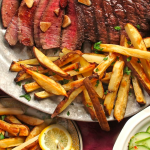The carnivore diet is a restrictive low-carb diet where you only consume meat and meat products. It’s becoming immensely popular because of its tremendous health and weight-loss benefits.
Once you have achieved your goal, you can always go back to your normal balanced diet containing all the major food groups and more carbs. However, transitioning off the carnivore diet might not be as easy as it seems.
If you come off too quickly, you could lose all the benefits, and experience weight gain, bloating, and stomach disruption.
Here we give some tips for how to come off a carnivore diet safely, and how to follow the diet temporarily for maximum results.
TABLE OF CONTENTS
Start Slow and Take Baby Steps
Starting slow is the best advice you can get whenever you are starting or coming off a diet. Making huge changes at once might increase your morale, but is highly discouraged in the health community. Baby steps assure your destination.
Start with introducing small amounts of carbs into your diet, and consume less than 50g of carbs each day. Most of these carbs should come from healthy vegetables and fruits, which contain fiber and lessens the carb load. Avoid refined carbs or sugar at this point.
Increase carbs by 10 gm each day, and introduce fats, cheese, and curd for good probiotics. Do not indulge in binge eating your favorite snacks or pizza! With each passing day, introduce more food items and see if your body reacts badly. Stay away from any that cause bloating or sudden weight gain.
Give yourself at least one month before starting a balanced diet.
Track Your Daily Food

We often forget what we eat, which means we can lose the benefits of the carnivore diet and revert to our old habits.
Keeping a journal or recording your daily intake of protein, carbs, and fat in an app helps a lot to stay on track. You should be aware of what you eat and how much.
Track your macros and calories closely. Macros should change slightly on a daily basis by a 10% increase in carbs. If you start with 50g carbs, make sure you eat only 55g carbs the next day, and so on.
For protein portions, try to cut them down until you reach 25% of your daily diet. Consume proteins according to your body weight. If you weigh 170lbs, you need at least 80g of protein daily (1g of protein per lb of bodyeight is ideal if you workout a lot).
Tracking your food is keeping a check on yourself. Be strict with yourself in order to reap the maximum benefits.
Avoid Processed Sugar at all Costs
After a carnivore diet, you may crave sugar more than usual. Control your sugar cravings by eating sweet fruit like apples, bananas, or cherries, which contain natural sugars and do not spike your insulin levels like table sugar.
Do not consume more than 4g sugar even after transitioning off the carnivore diet. You will be fatigued, lethargic, and tired after a sugar crash. All that hard work may be vain if you don’t follow some strict rules after diet.
Can You Temporarily do a Carnivore Diet?
Yes, for short-term goals, a carnivore diet is a great option. However, the carnivore diet has both pros and cons.
Going on a strict diet for life is a hard decision, especially when daily food choices do not revolve around your diet. The carnivore diet can be a reboot for you. It will eliminate all the toxins from your body and cleanse you from within.
A carnivore diet reduces your cravings, especially sugar cravings, and resets your metabolism. It gives you an autoimmune boost. By eating real food like our ancestors, you get plenty of iron, protein, zinc, and other minerals.
You should follow the carnivore diet for 20–30 days and then eat a balanced diet. You can try the carnivore diet during holidays or when it’s easy for you to follow.
Just following a temporary carnivore diet twice a year for one month promises major positive changes in your body.









Leave a Reply